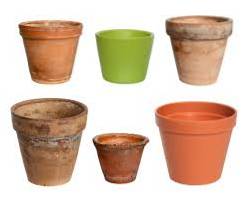Sometimes punching holes in planters can be accomplished with a nail. Another interesting tool that some people use for drilling a drainage hole is a rotary tool often referred to as a Dremel. A simple electric drill, properly fitted with the right bit, can add the necessary holes in the bottom of a container.
- How do you make a hole in the bottom of a planter?
- What do you do if your planter doesn't have holes?
- Should I put holes in bottom of planter?
- What do you put in the bottom of a planter for drainage?
- How many holes do I drill at the bottom of a planter?
- What plants can grow in pots without drainage holes?
- What can I use to fill the bottom of a large planter?
- Do you put rocks in the bottom of a self watering planter?
How do you make a hole in the bottom of a planter?
- Use a nail with a sharp point.
- Set the plastic plant pot upside down on a flat surface. Put on safety goggles to protect your eyes from plastic shards.
- Place the nail on to the marked spot on the bottom of the plastic plant pot.
- Tap the nail firmly with the hammer until it punches a hole in the plastic surface.
What do you do if your planter doesn't have holes?
Some experts suggest using a layer of pebbles as a sort of drainage layer in those pots without drainage holes. This technique allows excess water to flow into the space with the pebbles, away from the the soil and therefore the roots of your plant.
Should I put holes in bottom of planter?
Holes in the bottom of the planter are essential for proper drainage. The holes give the excess water an escape route so it doesn't stay in the soil. Many flower pots come with only one drainage hole. ... For example, you can safely drill a plastic or wooden planter to make additional holes.
What do you put in the bottom of a planter for drainage?
Put a layer of gravel in your plant's drainage tray, or down inside a decorative planter, then sit your plant pot on top. The gravel will hold water and increase humidity, while keeping your plant's roots up out of the puddle.
How many holes do I drill at the bottom of a planter?
In Purdue's bulletin on container gardening (http://www.hort.purdue.edu/ext/HO-200.pdf ), they say: "To provide drainage, drill three or four small (1/4 inch) holes in the bottom of the container. Holes larger than 1/4 inch in diameter will allow too much soil to escape.
What plants can grow in pots without drainage holes?
13 Amazing Plants That Do Not Need Drainage Holes
- Snake Plant. One of the best indoor plants for beginners, the Snake plant is one of our top choices when it comes to plants that do not require drainage holes. ...
- Oleander Plant. ...
- Chinese Evergreen. ...
- Kupukupu Fern. ...
- Crotons. ...
- Dumbcane. ...
- Schefflera. ...
- Pothos.
What can I use to fill the bottom of a large planter?
Options for Lightweight Pot Fillers
- Recycle Plastics. Plastic Water/Soda Bottles. ...
- Reuse Packing Materials. ...
- Unused Plastic Pots Turned Upside Down.
- Recycled Crushed Cans.
- Natural Materials. ...
- Recycled Cardboard, Newspaper (Also for short term use only.)
Do you put rocks in the bottom of a self watering planter?
You do need a nice substantial layer of rock ( or one of the above) if you don't have drainage holes at the bottom. (Yes you want drainage holes, but I know some of you are going to use cache pots without holes to plant in any way.) The substantial layer on the bottom gives a place for the excess water to go.
 Planetagarden
Planetagarden



